Hello BuzzFeeders,
Today I’m sharing our latest data on diversity at BuzzFeed and the results of the third party analysis on pay equity. Here are the headlines:
The US employee population is 57.53% White, 13.29% Asian, 9.85% Black, 8.9% Hispanic or Latinx, 4.98% Two or More, and 0.5% other groups. We continue to be a majority-female company, at 61.9%. We increased the representation of Black and Hispanic/Latinx employees from 2019, when they represented 7.7% and 7.5% respectively.
Gray Scalable did an independent analysis of pay equality at BuzzFeed and found no pay disparities. This means employees at the same level, location, and job title, get paid equitably regardless of their ethnicity or gender. To be clear, the analysis did not look at how people are leveled or whether all employees are at the right level for their job responsibilities. We will continue to evaluate and adjust levels. With that caveat, I was pleased we were able to independently verify that we have pay equality within levels at BuzzFeed.
Although we have BIPOC leaders and managers at BuzzFeed, we don’t have significant representation at all levels of the company. We are more diverse at junior levels of the company, and have proportionally fewer BIPOC employees in senior roles. We need to do more work to make sure that we are diverse at every level of the organization, especially in more senior roles.
Over the past 12 months, 46.9% of our new hires (who self identified) were people of color, compared to 44.3% in 2019. We will continue to make recruiting a focus in our diversity strategy.
First, I want to thank all the people across BuzzFeed who’ve worked so hard this year pushing for DI&B improvements, doing analysis, and making positive changes. We’ve got more to do, but we should celebrate the work and progress our teams have made so far. We are one of the most diverse companies in our industry and we should be proud of the inspiring work being done by BIPOC employees and allies, our DI&B council, and Dionna Scales. These efforts are making BuzzFeed a more inclusive workplace and the work is appreciated and noted.
Second, we all agree we have more work to do in key areas:
Leveling needs to be a continual focus to make sure people are at the right level for their job responsibilities.
Actively recruiting, hiring and retaining BIPOC leaders needs to be a continual focus, especially senior management roles.
Ensuring equity and fairness in access to career development needs to be a continual focus, so we can support growth in promotion rates and advancement for BIPOC employees throughout the organization.
You will see a focus on leveling, hiring, and promotion equity in the coming months and years. Each department has their own challenges to address and will focus on the areas where they need to make the most progress. In the charts and analysis below, you can see more detail about where we need to focus as an organization.
Building a company that supports diversity, inclusion, and belonging isn’t just a moral imperative, it is a business imperative. An inclusive culture with diversity at all levels of the organization is the only way we can build the leading media company for the most diverse generation in history.
The BLM protests and the ongoing racial reckoning create a huge opportunity for change within our company, our industry, and our society. We have a tremendous opportunity to hasten the transition to a multicultural, pluralistic society, to accelerate progress toward racial and gender equality; within our own company culture, in the content we create, and in the markets we serve. There are forces that are trying to stop this transition – major change always meets resistance from the existing power structure and the persistence of prejudice, bias, and bigotry. But we will win this fight if we work together to build a better, more equitable future. We will win if we embrace the change that needs to happen in our industry and the world. We can’t let this opportunity pass us by. We must rise to the occasion.
Please see below for all the data and analysis.
Diversity Results
Methodology:
- This data is based on all regular/staff employees who self-reported gender and race/ethnicity (including full-time, fixed-term and short-term employees). Data reflects best-available information as of 7/15/20 (Gray Scalable) and 9/18/20 (internal data). Due to rounding, undeclared employees, or unavailable data, values may not always sum to 100%. Because we are using two data sources that were taken at different times, the numbers won’t always match up exactly.
- Note that in addition to collecting employee gender information using male/female/undeclared, as required by many governments, we also allow employees to voluntarily self-identify from an expanded list of gender identity options including cisgender, transgender, non-binary, and more. Due to participation rates and sample sizes, the former (male/female/undeclared) is used for this report.
- Because race/ethnicity data is governed differently in different countries, we typically only report this information based on US data. 43% of our international employees chose not to volunteer their ethnicity information. Since gender identity options are more consistent around the world, we are able to report on our gender numbers globally (as opposed to just the US numbers).
Data:
Race & Ethnicity (United States)
↑ Not including employees who declined to self-identify or who did not provide information, 37.5% of BuzzFeeders identify as a race/ethnicity other than our most common group, White (non-Hispanic or Latinx).
This is compared to 34% in 2019.The US employee population is 57.53% White, 13.29% Asian, 9.85% Black, 8.9% Hispanic or Latinx, 4.98% Two or More, and 0.5% other groups. This breakdown is comparable (and often more diverse) than peer companies in the media and tech industries who have publicly released their data.

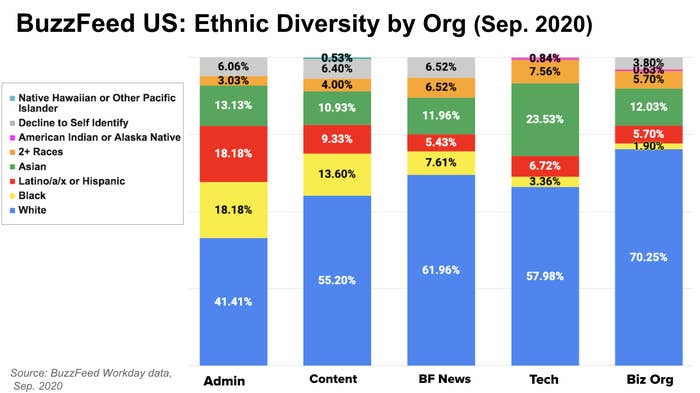
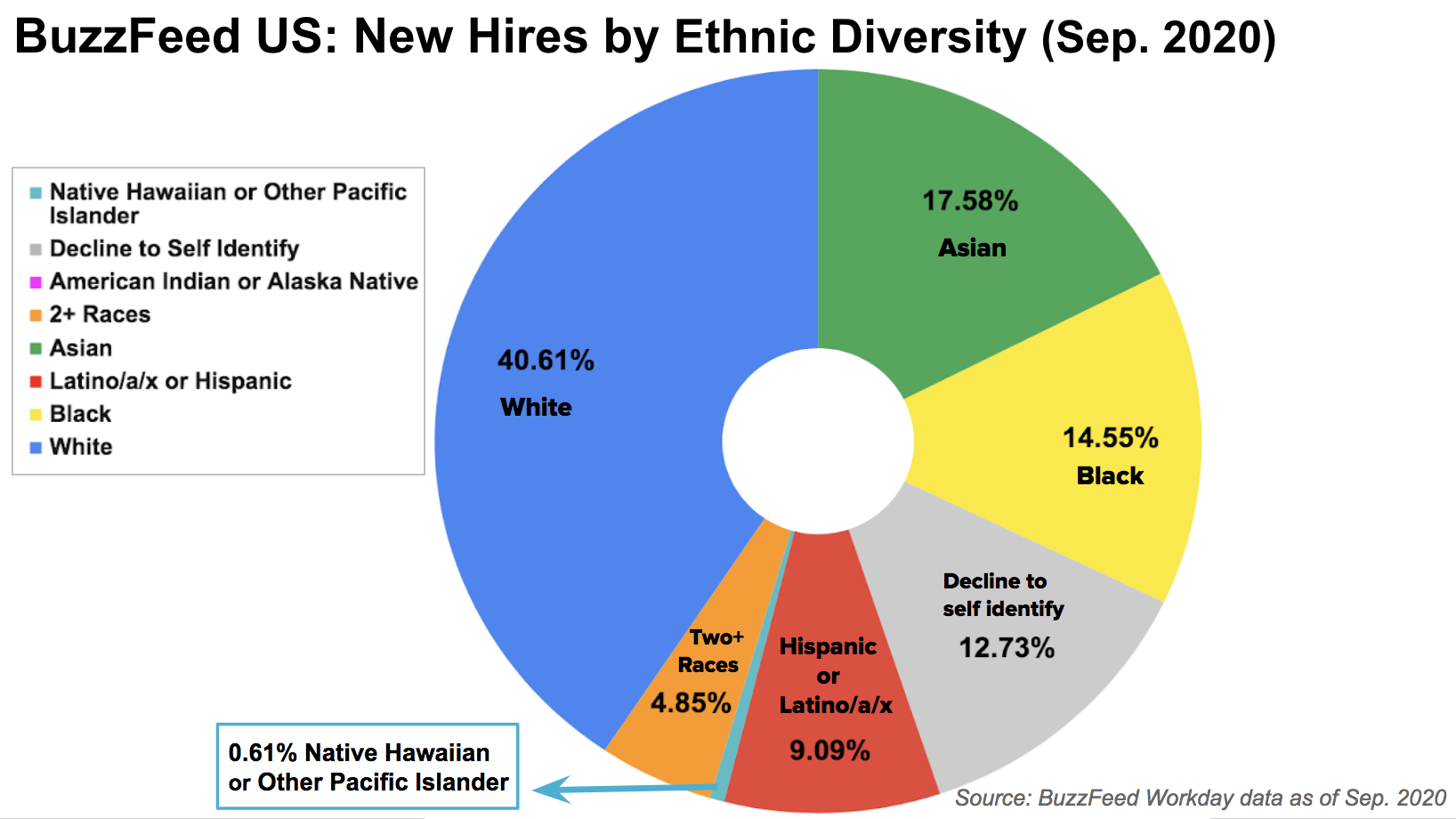
↑ Compared to 2019, we’ve seen an increase in the percentage of Black and Hispanic or Latinx employees. In 2019, 7.7% of our employees were Black and 7.5% were Hispanic or Latinx, as compared to 9.85% Black and 8.9% Hispanic or Latinx in 2020.

From Sept 18, 2019 - Sept 18, 2020, when looking at US-only promotions (where we have more thorough race/ethnicity data), groups were promoted roughly in line with their overall company representation in 2019, since employees are usually at the company for at least a year before being promoted.

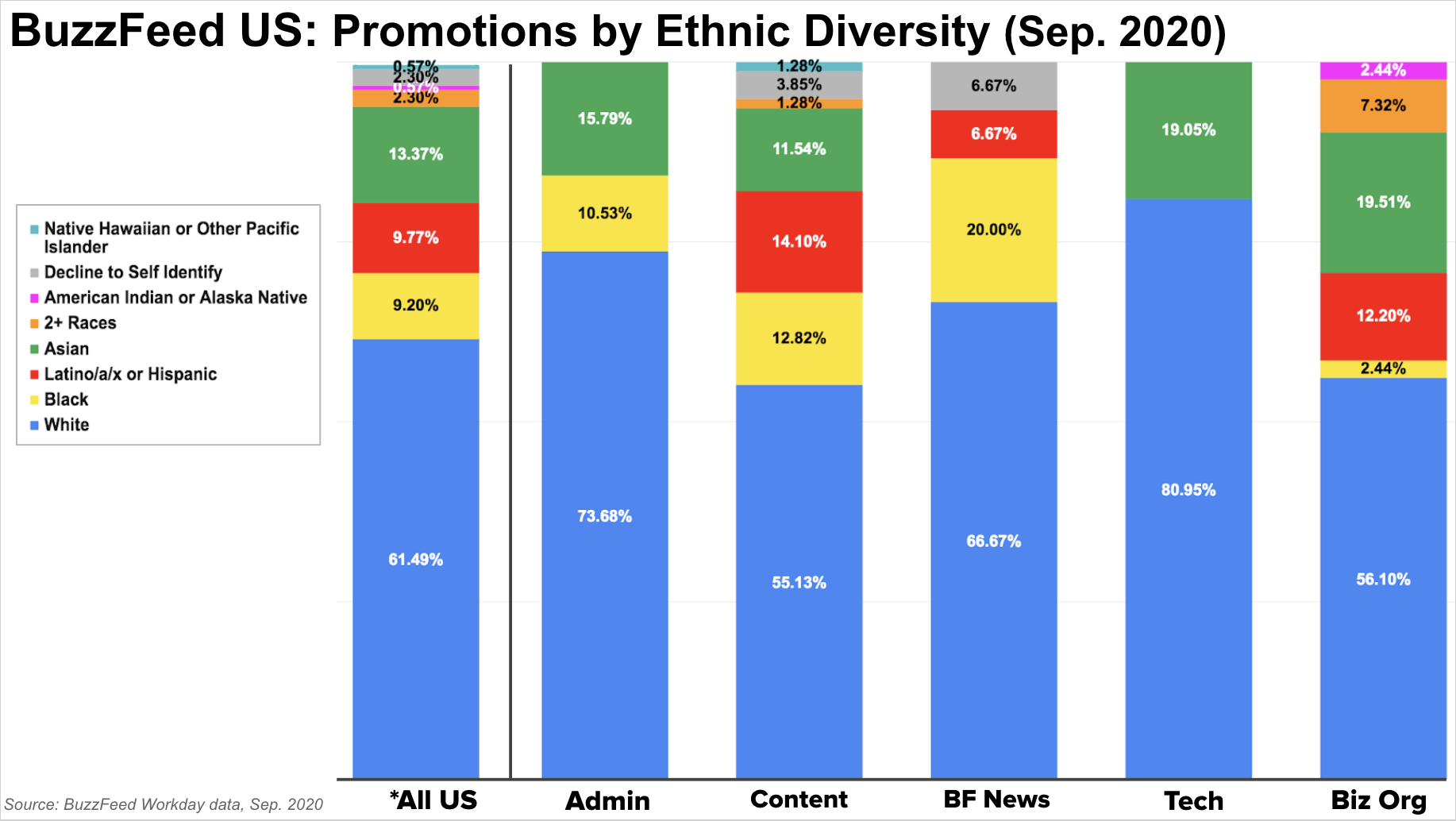
We have underrepresentation of BIPOC employees at senior levels of the company, which is highlighted in both our data from Workday and analysis from Gray Scalable. Though BIPOC employees are being promoted at the same or greater rate than their representation in the company in 2020, we need to increase representation of people of color at the higher levels. Employee representation decreases for BIPOC employees compared to white employees across levels 6-9.
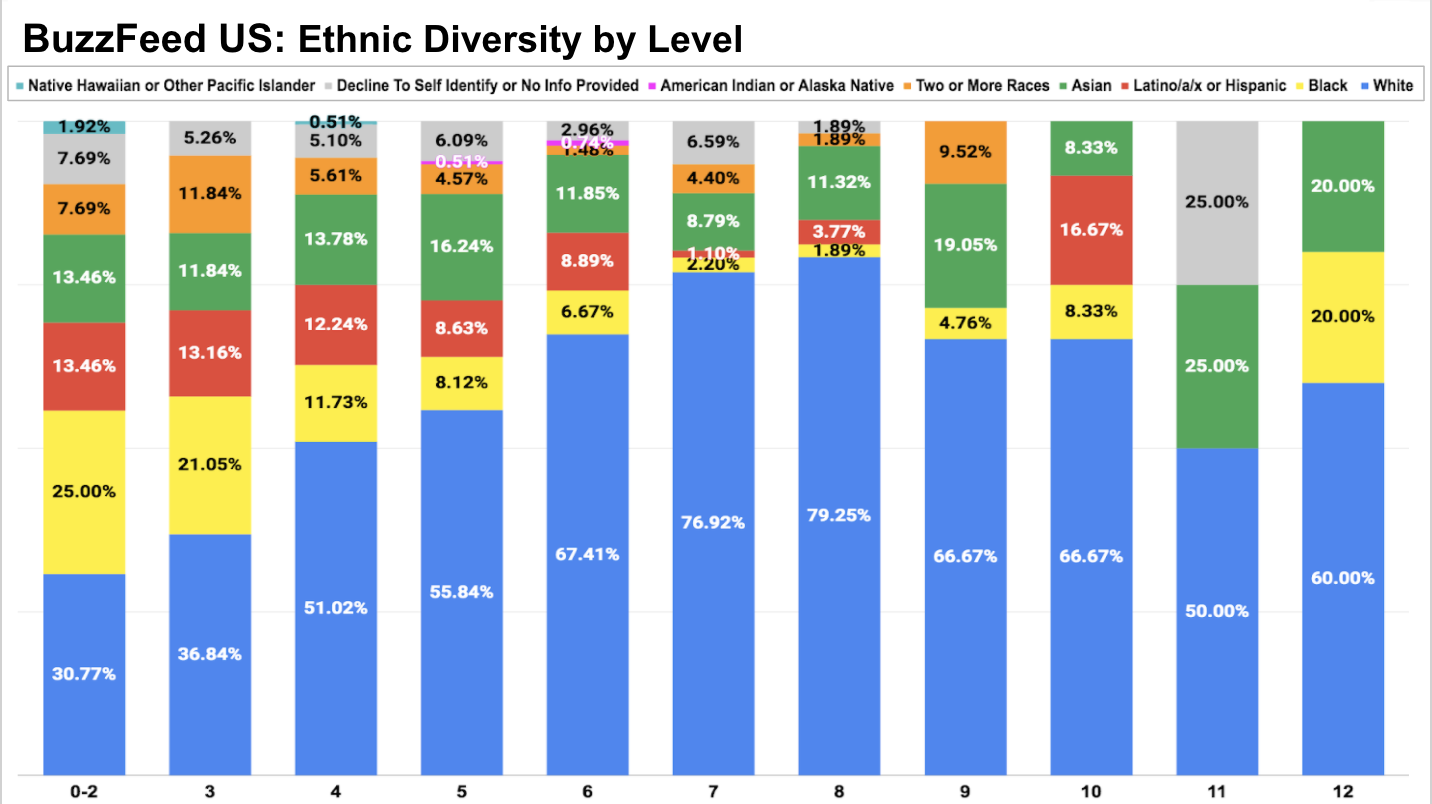
Gender (Global)
BuzzFeed continues to be a majority-female company, with numbers staying consistent with or up from last year. Currently, 61.9% of BuzzFeeders identify as women, including:
- 60% of people managers (up slightly from 2019)
- 52% of BuzzFeed leaders (director level & above)
- 40% of our Tech org, up from 35% in 2019. This improvement follows an ongoing diversity effort in Tech.
- 62.7% of new hires (employees with less than 1 year of tenure at BuzzFeed) compared to 51.7% of employees with 5+ years of tenure
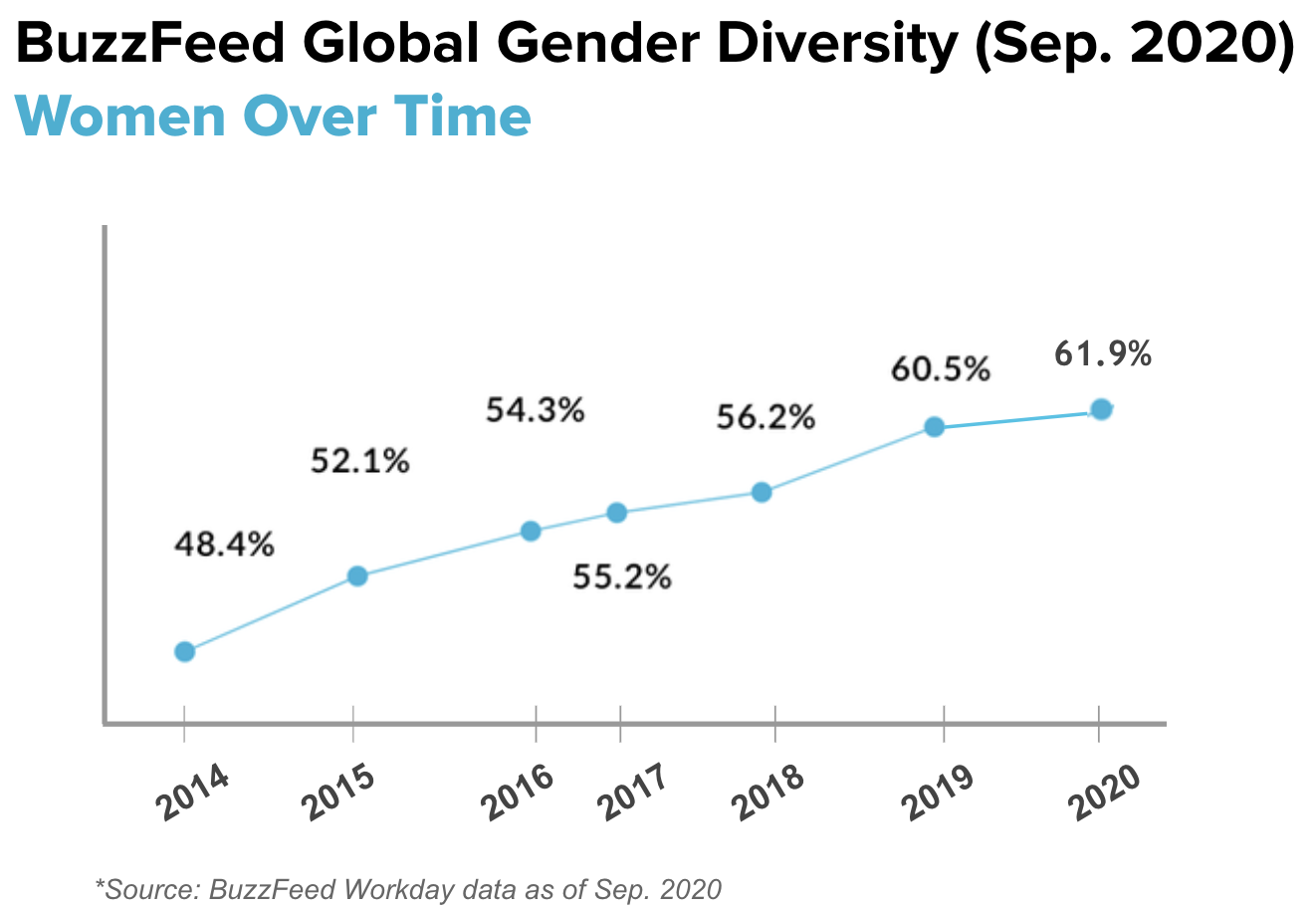
Women account for nearly 64% of promotions to date in 2020.

Sexual Orientation (Global)
BuzzFeed allows our employees to voluntarily self-identify in a way that reflects their true selves. 9.5% percent of BuzzFeeders have actively identified as a part of the LGBTQ+ community.
Age (Global)
BuzzFeed’s success in our early career programs, particularly our Fellowship programs, drive a workforce in which 50% of BuzzFeed employees are between the ages of 21 – 30.
The remaining 50% spans multiple age brackets, including ages 60 and higher.
Here's What We're Doing
Hiring:
Our DI&B Council has partnered with the Recruiting team to come up with new processes to ensure that more people of color & other underrepresented groups are considered for open positions. The Recruiting team is working with individual organizations now to implement changes.
These changes include partnering with diversity organizations, hosting recruiting events, and having informal conversations with prospective candidates.
These partnerships & events will help us continue to hire people from underrepresented groups in the short and long term. Partnerships include (but are not limited to): The Multicultural Advertising Internship Program (MAIP), Council of Urban Professionals (CUP), Out in Tech, Code 2040, and HBCUs to explore recruiting events for full-time and internship roles.
We will also continue to have diverse hiring panels and are implementing new guidelines for recruiters and hiring managers to follow to ensure that they are attracting and considering candidates from underrepresented groups.
Advancement:
We are committed to addressing the underrepresentation of people of color within the leadership of the company. We are promoting BIPOC employees at a rate consistent with their representation. But, the data also shows that white employees are being promoted at a rate higher than their representation. In order to close this gap, we need to both hire more BIPOCs and promote BIPOC employees into more senior roles.
We are actively focusing on this issue through the above changes to our hiring strategy plus new processes that we’re rolling out for our current and future promotion cycles.
The DI&B Council has committed to focusing the rest of their efforts this year on ideating and implementing programs to help advance BIPOCs across the company.
Individual divisions within the company are also committing to opening new leadership opportunities widely, and inviting all employees to participate in a transparent and fair process, in order to support everyone’s internal career growth, including BIPOC employees. creating ways to support and provide opportunities for our BIPOC employees to grow at BuzzFeed. Some examples include:
The BuzzFeed.com team created and filled 13 new leadership roles (these recent promotions are not reflected in this data), News has promoted two people and has new leadership roles open, and the Tech Org is continuing a self-nomination process for promotions. In addition, a new slack channel #internal-mobility now lists all new roles on our internal job board.
Pay Equity Results
Summary:
The BuzzFeed People team regularly conducts pay equity analyses. This year, in addition to our regular process, we also contracted with Gray Scalable, a neutral third-party vendor, to run an analysis completed in July 2020.
Gray Scalable did not find statistical evidence of pay inequity at BuzzFeed, for people at the same level and same job title in the same location. We’ve worked hard to ensure that we pay equitably within levels regardless of race, ethnicity and/or gender.
Methodology:
Pay equity is measured by using a Compensation Ratio, which shows where a salary falls relative to the midpoint of a pay range.
Compensation Ratios control for market location, job function, and level.
1 = midpoint of the pay range. 0.95 = 5% below the midpoint. 1.05 = 5% above the midpoint.
If the Compensation Ratio is a 1 for a particular group, every employee’s salary within that group is exactly at the midpoint of the pay range, meaning no employee in that group is paid higher or lower than the midpoint of the range.
The goal of the exercise is to see if the Compensation Ratios of different genders and ethnicities are close together.
Data:
Gray Scalable found that there are no statistically significant differences in pay between race/ethnicity groups or genders within current levels. They found this to be true both at an all-employee level, as well as within all divisions (Admin, Biz, Content, News, and Tech).
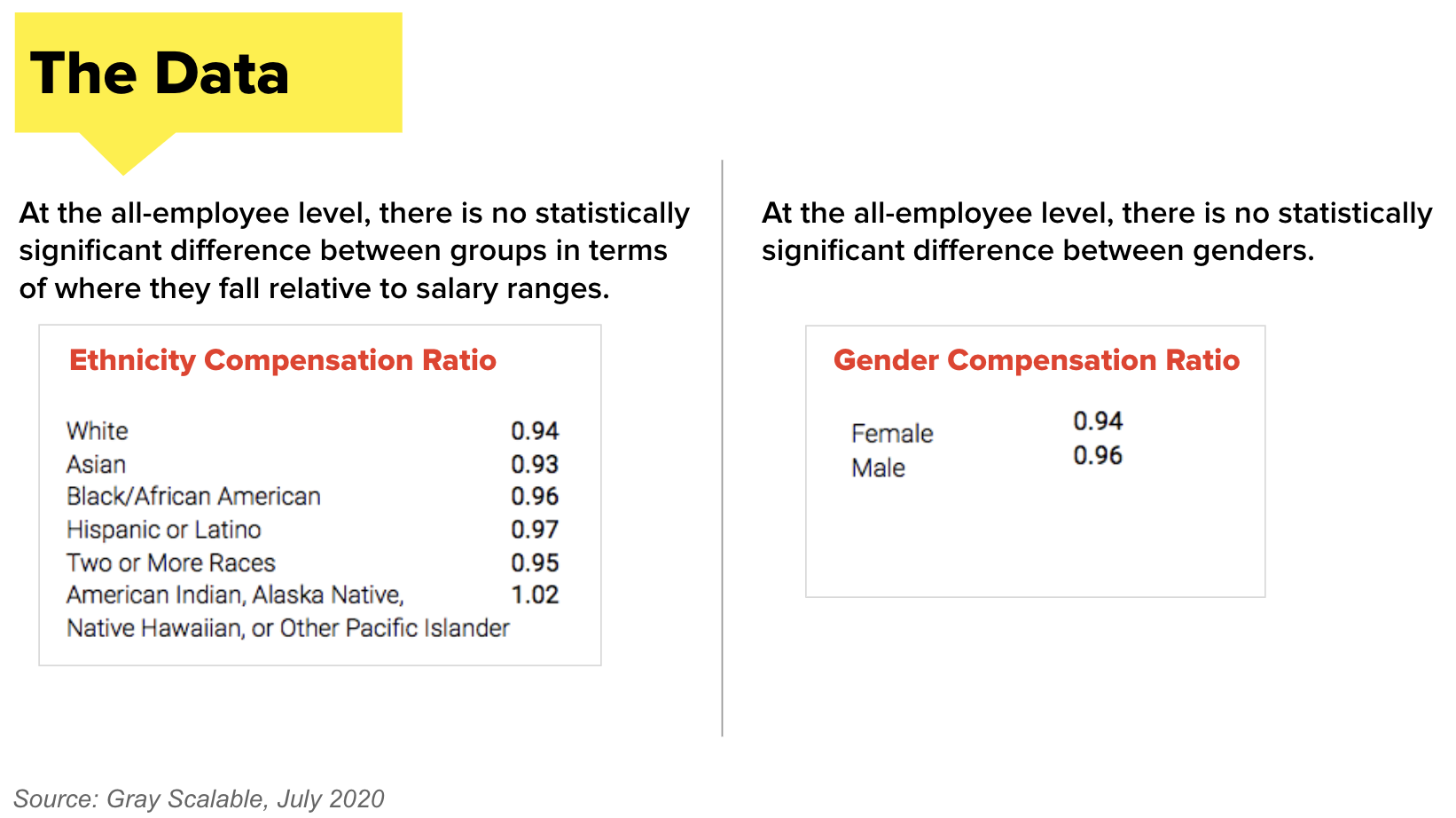
Here's What We're Doing:
Our approach to pay equity is to constantly be vigilant. We run pay equity analyses during our promotion and merit increase processes annually. We also conduct this analysis at other points during the year at the org and business level.
This is ongoing work and we are constantly iterating on our processes and listening to our employees. We strive to ensure that our employees are leveled correctly for the work they are doing.
While the most recent analysis didn’t show any pay inequity within levels, we are implementing new policies and programs to increase access to development and promotion for everyone, which we expect to positively impact BIPOC employees.

